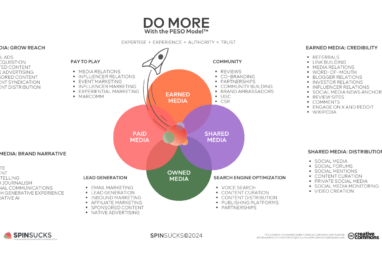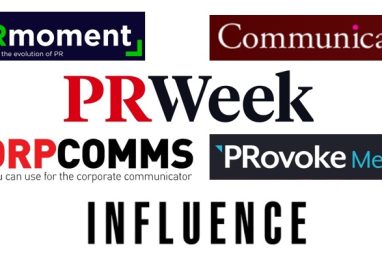In the public sector, we ignore ‘old media’ at our peril
About the author
Our guest authors are what make PR Place such a vibrant hub of information, exploration and learning.

This is an unedited CIPR Professional PR Diploma Unit 2 thought leadership piece from Richard Eaton.
To reach some of our key audiences, the public sector still needs the traditional media – now, in fact, more than ever
Want to know the magic formula in the world of communications right now? It’s EC = MC: ‘every company is a media company’. First coined by Tom Foremski, a journalist turned blogger, it sums up the concept that companies in the digital age control their own destiny when it comes to communicating with clients, staff, and the wider community.
Across the country, public sector comms teams are busy taking Foremski’s formula to heart, building online newsrooms for their stories and turning broom cupboards into mini film studios, ready to put their chief exec’s face all over YouTube.
Great, you might think – there’s a digital revolution going on and the public sector should be part of it. Yet there also seems to be a growing tendency amongst communications teams to think that, by transforming their NHS trust, police constabulary or local council into a media company, they can bypass the broadcast and print media altogether. Talk ‘straight to the people’, as it were, without the message being mangled by some rushed reporter. After all, when surveys like the Edelman Trust Barometer suggest the public have lost faith in the media anyway, that same public won’t mind if the middleman gets cut out. Will they?
That kind of thinking is mistaken, on a number of levels. It undervalues the clout (spelt with a ‘c’ not a ‘k’, you’ll note) that the traditional media – particularly the broadcast media – still possesses. It ignores the sorts of audience that we in the public sector should be targeting. And it forgets the essential service that trained journalists provide in filtering and framing our messages so they really hit home.
Let’s take each of those points in turn. First, the ‘clout’ thing. People in this country talk about digital platforms like Google, Facebook and Twitter as if they are the now the only game in town. That may be true when it comes to advertising, but not when it comes to news.
Look at radio. Radio consumption in this country is still huge. According to RAJAR’s most recent figures, 90% of the population listen to radio, and for an average of 21 hours a week. That’s 48.7 million people tuning in live, half a million more than in 2004. When you think how many people also listen to pre-recorded podcasts now – which are excluded from RAJAR’s figures – then you could confidently say that a lot of people are still getting the news delivered into their ears.
Then there’s television. TV drama is obviously going through a golden age, and TV news consumption isn’t too shabby, either. In the week of writing this, BARB figures revealed that 11 of the 30 most-watched shows on BBC1 were news-related (nine if you exclude the One Show and Countryfile). On ITV it was six out of 30. According to Ofcom, television remains by far the most popular platform for news.
It’s not a stretch, then, to suggest that many people still start their day in the same way they did in 1995: by watching breakfast TV as they munch on their toast and get dressed, before jumping in the car and listening to John Humphrys, James Naughtie or Chris Evans on BBC radio on the way to work.
‘Clout’ isn’t just about breadth, though; it’s also about how far you are trusted. And here again, some of the traditional formats and traditional media players hold sway. BBC News is way out ahead in the trust stakes, both in its own surveys and in independent surveys like the Reuters Institute Digital News report. Even online, the BBC is easily the most popular choice amongst the British public when asked about their main source of news. There is less information available for other TV channels, but BBC research in 2015 suggested that ITV was the UK’s second most trusted news source. Channel 4 News, says Ofcom, continues to be rated highly for its impartiality. As for the most trusted news format? That’s radio.
So when people say ‘the media’ isn’t trusted, arguably what they mean is the print media – especially the tabloids, with their partisan reporting and questionable regulation. And that’s partly why newspaper sales have been falling – not just since the emergence of the internet in the 1990s, but since the emergence of television in the 1950s. Print is an outmoded delivery mechanism for news; television and radio, however, have got legs.
Now let’s turn to the second point: the audiences that we in the public sector need to reach. Clearly the public sector has a duty to communicate with everyone. However when it comes to the business of changing attitudes and behaviours – and particularly encouraging healthier, safer living – it’s to the more deprived and isolated members of our communities that we must turn our attention.
As we all know, and the Marmot Review confirmed in 2010, there is a clear link between socio-economic deprivation, social isolation and a whole range of health issues and lifestyle disadvantages. In England, people living in the poorest areas will die an average of seven years earlier than those living in the richest areas – and ONS research shows that the differences can be seen within the same towns and cities, in adjoining neighbourhoods. Looking at isolation, a research paper in 2015 suggested that lacking social connections is as damaging to your health as smoking 15 cigarettes a day, and nearly 30% of those aged 80 and over told the ONS in 2014/15 that they felt high levels of loneliness. The public sector must help these communities to understand the support that is available, and ‘nudge’ them into making healthy, safe, advantageous choices.
Fine, you might think; target those communities on Facebook. Alas, no, because socio-economic deprivation and social isolation go hand in hand with digital exclusion. 75% of those who suffer ‘deep’ deprivation have only limited engagement with internet-based services. In the last major government report on the subject, in 2008, that equated to about 13 per cent of the UK’s population, or six million adults. An Ipsos Mori survey for Doteveryone in 2015 found that 23% of the UK adult population, or an estimated 12.6 million adults, lacked basic digital skills. As income dropped, so did skills.
It’s quite a wake-up call to understand what this digital exclusion means in practice, in terms of access to media. Those experiencing the deepest deprivation and isolation are, according to that 2008 government report, likely to have limited access to the Internet, with only a minority getting online through their local library. Smartphones are out; Doteveryone found that only 65% of C2DE adults own one, and only 26% of over 65s. What these individuals probably will have, however, is a radio and TV set.
This shows the importance of broadcast media in reaching parts of the community that other media do not reach. We might like to think that our own in-house videos will be accessible – but unless we have our own TV channels, they won’t be accessible enough.
Securing television and radio coverage is vital to reach these groups, then, particularly as public sector budgets are reduced and opportunities to pay for other forms of non-digital communication disappear. Gone are the days when most public sector organisations could afford to print materials and post them through every door. As for media advertising – well, the costs have long been prohibitive.
It seems that several national public sector bodies – organisations like Public Health England – have an understanding of deprived and isolated audiences, and how to reach them. Public Health England’s ‘be clear on cancer’ health campaign has specifically targeted radio stations and television channels for media coverage (and advertising, lucky things). That makes sense, as the campaign is aimed at people aged over 50 from lower socio-economic groups.
In contrast, local public sector organisations sometimes seem intent on communicating through digital channels, even when it’s palpably illogical. Take a campaign on which yours truly collaborated, aiming to get more people to join a collective bargaining scheme and reduce their energy bills. The campaign involved several local public sector organisations and was run on ‘owned’ digital channels and social media, partly because people had to go online to sign up. Only one problem: the sort of people who are online are those who can already compare and switch energy tariffs with ease. The people we needed to reach – the ones paying over the odds for their energy – were generally unaware that the campaign existed. Unsurprisingly, the campaign was not a success.
And yet – at the time of the campaign, my colleagues and I were swept up in the excitement of watching the Facebook analytics tick along: another like! Another share! Those were quirky little outputs, it turned out, but not the outcomes we really required. And that is the danger of the kind of measurement that digital media allows; it offers fantastic real-time data, which gives you the illusion of control over every step in the decision-making process – as well as something to write in reports. But sometimes, you need patience and belief in the older, more indirect ways of communicating – and methods of evaluation that complement that.
It’s almost reached the point where separate, distinct sets of channels are needed for public sector and private sector campaigns, because of the differences in the types of audiences the two sectors are targeting. Private sector businesses typically want to attract people with disposable income, to buy their goods and services; those are the people who are usually plugged in to ‘digital Britain’. The public sector often needs to reach out to those who are less affluent, and that means having to engage in the old pas-de-deux with journalists.
There’s a third reason why the public sector should maintain that relationship with journalists: because when it comes to ensuring our campaign messages strike a chord with target audiences, we need all the tools in their toolbox.
With the growing influence of the Behavioural Insights Team, we in the public sector might like to think we’ve nailed the use of ‘nudge’ messages to encourage attitude and behaviour change. The truth is that we still have some way to go. As the 2015/16 report from the Behavioural Insights Team shows, for every message that successfully persuades people to ‘follow the herd’ and pay their tax on time, there is another – a positively framed message about ‘walking away from diabetes’, for instance – that has no clear effect at all.
Thanks to the work of recent generations of psychologists, we are now beginning to understand the complex range of factors affecting how messages are deciphered by the people who receive them, particularly when those recipients are from less well-educated backgrounds, like some of our target audiences. As the ability to process arguments decreases, other peripheral ‘cues’ or mental shortcuts become more important in determining whether people are persuaded by a proposal or argument. Those cues might include positive, well-lit visuals, catchy music or a likeable presenter; just the sort of details that journalists, their producers and camera operators naturally obsess about.
Sometimes, simply having our messages delivered by someone else – by a journalist or reporter who doesn’t represent ‘the public sector’ – may count for a lot in terms of how those messages are evaluated by an audience. We know from the theory of reasoned action that introducing new voices, ones that an audience respects, may encourage them to change their thinking, and ultimately their behaviour. And as we have seen, our broadcast journalists still command some respect and trust.
If a journalist challenges your comms team to tell a story from a different angle, then, it’s worth listening and responding; not just to ensure the story runs, but also to experiment with the messaging, to see if there are new ways of connecting with audiences. Ultimately we have to remember that journalists want to cut through the noise as much as we do, to maintain their ratings. They get more practice than most comms officers at perfecting their messages – no annual report-writing duties for them – and they probably spend more time out and about, learning to engage with different communities. Not every journalist is a ‘churnalist’.
As our organisations move towards digital initiatives to increase efficiency – whether that’s ‘channel shift’ in local government parlance or ‘digitalisation’ in the NHS – the temptation will be to shift communications in the same direction. But we must remember the communities who will miss out if we do, and the impact that excluding them might have on their living standards, health outcomes and, ultimately, the public sector’s bottom line.
We may all be working for media companies now, but we must think like public servants before all else.
This article was submitted as part of an assignment for the CIPR Professional PR Diploma with PR Academy.


